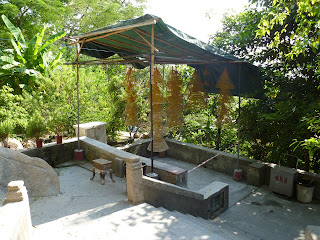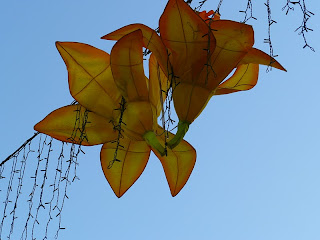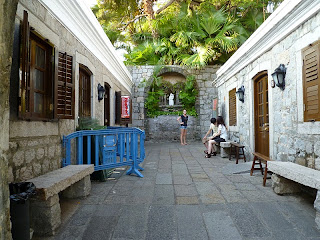Since being in Hong Kong, people have been asking us, "Are you planning on going to Macau?" So, naturally, I researched it to see what the fuss was all about. Macau is the only part of China that is allowed by the Chinese government to have gambling. Many people make day trips or weekend trips to Macau for that very reason. However, Macau also has an interesting history and a lot of cool sites to see as well. Macau was founded by the Portuguese before being taken over by China. As such the two languages spoke in Macau are Cantonese and Portuguese, not to mention that the architecture found on this island is an interesting mix of Chinese and colonial. So, we decided to make a day trip of it! To get to Macau from Hong Kong, you take a ferry that leaves every 30 minutes or so and takes about an hour.
Here we are on the ferry ride over:
And the ferry was very nice and air conditioned (which was a huge plus):
The ferries are very big and hold up to 600 people:
This is a view of Macau from the Macau Tower (where, on the 61st floor, you can walk around an enclosed viewing terrace):
Now this totally freaked me out and I would stand on it, but James was totally fine with it:
I was not happy about taking this picture because I was SURE James was going to fall through any second, but he insisted....
You can actually bungee jump off the tower (it's the world's highest bungee jump)... I declined...
Our second stop in Macau was A-Ma Temple. There was a dragon-dancing team practicing outside!
Entrance to the temple
Dragon on a pole . . .
Dragon on a bench (or two...)
Here is one type of incense burning that we thought was unique - the incense are in "swirl" cones.
Pretty roof on a temple building
Nice Dragons . . .
These were the typical apartment buildings we saw in Macau. We were surprised by all the iron bars on the windows, balconies and even rooftops. Hong Kong really does not have this at all. So, we wondered if crime either is or was more prevalent here at some point.
The street signs are all in Portuguese and Cantonese.
Evidently the sights to see in Macau were churches and temples. We ended up finding more churches than temples. The earliest was built by the Jesuits in the 1560s. This church is St. Dominic's - established by the Dominican in the 1590s. In 1644, a soldier who supported the Spanish war against the Portuguese at the time was murdered at the altar during Mass here.
Here is the first Western theater - also a UNESCO/historic site (most of these were listed as UNESCO sites). It was built in the 1860s and was one of the first Western style theaters in China.
This is St. Augustine's. Built by the Spanish in 1586 and taken over by the Portuguese three years later. Crazy that Macau was colonized before New Orleans . . . St. Louis Cathedral was founded in 1720.
I liked the foyer floors . . . the tile work in Macau is magnificent.
Here is the outside of the Sir Robert Ho Tung library in Macau. It has some VERY old Chinese books and manuscripts.
Typical street in the center of Macau looking towards the Senate Square. You can see the Pagoda in the square at the end of the street.
Senate Square
Mosaic tile floors were everywhere!
The old post office on the square.
The Pagoda blends in nicely with the original Portuguese architecture. . .
The whole square is tiled in this wave pattern.
Here is a market near the square. James really liked the bunches of little bananas.
Exhibit A.
They had Christmas lights and these flowers strung between the buildings on the square.
Another church on the square.
Here are the ruins of St. Paul. This was by far the largest church in Macau, built in 1627. However, it burned in 1835 and the stone facade is all that remains today.
Yes, James is holding a Blizzard from Dairy Queen. In his defense, it was SO hot and we had walked a ton.
You could walk up to the top windows of the ruins, and here's the view:
This is the entrance to the Guia Fortress. My Portuguese is rusty . . .
The Fort had some very pretty buildings and walkways.
At the top of the fort is the Macau Museum. It was closed for the day by the time we arrived.
Sitting on top of the fort.
Every good fort still has cannons. . . At this fort, the cannons pointed only to the South China Sea. They positioned no cannons facing China to indicate that the fort was only to stop European invaders.
Side-view of the ruins of St. Paul
Pretty mosaic tile around a street sign
Here is Macau Mansion. It was built in 1889 by a wealthy man who was the first in Macau to be awarded a gambling franchise. He hung himself in the mansion after the local Chinese government reversed its position on gambling and he was forced into financial difficulty. Eek!
The woodwork was incredible.
Again, the floors were great too.
As you can see here, there were several open courtyards as well. Until you looked up, these small courtyard often just felt like another room in the house.
Here is the last church of the day - St. Lawrence's! It was first built in wood in the 1560s, but was reconstructed in stone in 1801. When we peeked inside, a Portuguese mass was ongoing.
One of my favorite mosaics - a sun with an Alpha and Omega.
But James LOVED this ship.
Our last trip in Macau was to the Venetian -- the world's largest casino. It was on Taipa Island, just a short can ride from the main island of Macau. Cabs in China are SUPER cheap. The most expensive fare we have paid so far was about $7 U.S. Here is the foyer as you enter the Venetian.
Here, we are on a balcony overlooking some of the tables. We had dinner in a restaurant at the Venetian. It was SO good. James lost $20 MOP on the slots, just to say that he gambled in the world's largest casino. $20 MOP (Macau's money) = about $2.50 U.S. BIG SPENDER.
During the month of September, Macau hosts an international fireworks competition every Saturday night. We saw one of the countries show before heading back to Hong Kong. It was one of the best fireworks shows we had seen. If we can figure out how to post videos - we will put a few in a later post.
Macau = GREAT DAY TRIP!





































































No comments:
Post a Comment